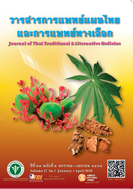ฤทธิ์การยับยั้งการเจริญของเชื้อแบคทีเรียก่อโรคในมนุษย์ของสารสกัดมะหาด
Main Article Content
บทคัดย่อ
การศึกษานี้มีวัตถุประสงค์เพื่อศึกษาประสิทธิผลของสารสกัดจากแก่นมะหาดที่สกัดโดยวิธีการหมักด้วยตัวทำละลายชนิดต่าง ๆ ต่อการยับยั้งการเจริญของเชื้อแบคทีเรียที่พบเป็นสาเหตุของโรคต่าง ๆ อยู่บ่อยครั้งในมนุษย์ ผลการศึกษาแสดงให้เห็นว่าสารสกัดมะหาดที่สกัดด้วยเอทานอล 95% แสดงสมบัติในการยับยั้ง Aeromonas hydrophila TISTR 1321, Bacillus cereus TISTR 747, Bacillus licheniformis TISTR 1455, Escherichia coli TISTR 117, Staphylococcus aureus TISTR 746 และVibrio parahaemolyticus TISTR 1596 โดยมีค่าเส้นผ่านศูนย์กลางโซนการยับยั้งเท่ากับ 19.89 ± 0.67, 18.27 ± 0.69, 14.92 ± 0.98, 17.06 ± 0.66, 14.84 ± 0.82 และ 19.00 ± 0.42 มิลลิเมตร ตามลำดับ แต่ไม่พบฤทธิ์ในการยับยั้งเชื้อก่อโรคของสารสกัดมะหาดเมื่อสกัดด้วยเฮกเซนและน้ำกลั่น เมื่อหาค่าความเข้มข้นต่ำสุดในการทำลายเชื้อแบคทีเรีย (Minimum Bactericidal Concentration, MBC) ของสารสกัดมะหาดที่สกัดด้วยเอทานอล 95% จะมีค่าอยู่ในช่วง 3,125-25,000 ppm ข้อมูลในการศึกษาครั้งนี้แสดงให้เห็นว่าตัวทำละลายที่ใช้ในการสกัดมะหาดจะมีผลอย่างมากต่อฤทธิ์ในการยับยั้งการเจริญของเชื้อแบคทีเรียก่อโรค ซึ่งสารสกัดมะหาดที่สกัดด้วยเอทานอล 95% จะมีสมบัติในการทำลายเชื้อแบคทีเรียได้ทั้งแบคทีเรียแกรมบวกและแกรมลบ แต่อาจมีประสิทธิภาพการยับยั้งแตกต่างกันออกไปในแต่ละชนิดของเชื้อแบคทีเรีย
Article Details
เอกสารอ้างอิง
2. Alabri THA, Musalami AHS, Hossain MA, Weli AM, Al-Riyami Q. Comparative study of phytochemical screening, antioxidant and antimicrobial capacities of fresh and dry leaves crude plant extracts of Dutura metal L. Journal of King Saud University-Science. 2014;26(3):237-43.
3. Krishnamurthy SR, Sarala P. Phytochemical studies of Artocarpus gomezianus Wall. ex Trecul.var. lokoocha Roxb. fruits collected from various altitudes of Central Western Ghats. Indian Journal of Natural Products and Resources. 2013;4(4):398-411.
4. Hossain MF, Islam MA, Akhtar S, Numan SM. Nutritional value and medicinal uses of Monkey Jack fruit (Artocarpus lakoocha). International Research Journal of Biological Sciences. 2016;5(1):60-3.
5. Parkpoom T, Chantree K. A study of efficiency the mixed extract of Pistia Stratics Helianthus embolic Linn. in inhibit the microorganisms causing dermatitis. SDU research Journal sciences and technology. 2012;5(1):47-60. (in Thai).
6. Laovachirasuwan P, Phadungkit M, Namsawang T, Khumphuwiang J, Chaemphudsa C. Oxyresveratrol content and tyrosinase inhibitory activity of Artocarpus lakoocha heartwood extract. Journal of Science and Technology Mahasarakham University. 2015;34(6):547-50 (in Thai).
7. Teanpaisan R, Senapomg S, Puripattanavong J. In vitro antimicrobial and antibiofilm activity of Artocarpus Lakoocha (Moraceae) extract against some oral pathogens. Tropical Journal of Pharmaceutical Research. 2014;13(7):1149-55.
8. Shailendra Kumar MB, Rakesh Kumar MC, Bharath AC, Vinod Kumar HR, Prashith Kekuda TR, Nandini KC, Rakshitha MN, Raghavendra HL. Screening of selected biological activities of Artocarpus lakoocha Roxb. (Moraceae) fruit pericarp. Journal of Basic and Clinical Pharmacy. 2010;1(4):239-45.
9. Ratananikom K, Khannalao Y, Srirod S. Inhibitory effect of essential oils from local Thai medicinal plants against common human pathogens. Khon Kaen Agriculture Journal. 2014;42(4) Suppl:99-105.
10. Kenneth JW. Macroscale and microscale organic experiments. 2nd ed. Lexington: Massachusetts, D.C.; 1994.
11. Pandey A, Bhatnagar SP. Preliminary phytochemical screening and antimicrobial studies on Artocarpus lakoocha Roxb. Ancient Science of Life. 2009;28(4):21-4.
12. Cowan MM. Plant product as antimicrobial agents. Clinical Microbiology Reviews. 1999;12(4):564-82.
13. Yousef RT, Tawil GG. Antimicrobial activity of volatile oils. Pharmazie. 1980;35(11):698-701.
14. Rios JL, Recio MC, Villar A. Screening methods of natural products with antimicrobial activity: a review of the literature. Journal of Ethnopharmacology. 1988;23(2-3):127-49.


